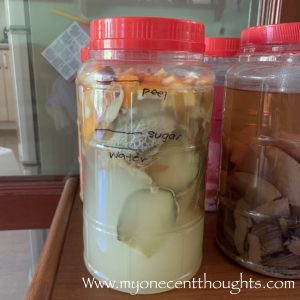Fermenting Eco-enzyme
Why did I start fermenting eco-enzyme? Ever since I read about zero waste lifestyle, we have been trying to practise it. But I can tell you, that it is EXTREMELY difficult. Hehe. Although I wouldn’t say that we can totally do it now, but we have cut a lot of waste by changing some of our living habits. So better than nothing lah… every little bit of effort counts, IMHO.
One of the initiatives we had started quite a long while back (I kept wanting to post about it but had been procrastinating…. as usual…) was fermenting eco-enzyme (EE) aka garbage enzyme. It makes use of food waste that would otherwise be thrown away, so why not, just put it to good use? It’s natural, healthy and organic (everyone uses this word, so ya… must follow the crowd.)
EE has multiple uses. It can be used as cleaning detergent, laundry cleaner (especially for people with sensitive skin like my DD), floor cleaner, stain remover, vegetable cleaner, plant fertiliser and pesticide.Not only that, it is extremely easy to do. Everyone who knows me, knows that I’m extremely lazy… can only do the easy stuff. So if I can do it, most people can, it’s a matter of whether you want to make the effort or not. So here goes….
What do you need for Eco-Enzyme (EE) :
- Fruit peels (I don’t use vegetable ends because I don’t like the smell…) I like to use a mixture of fruits, since we eat all kinds of fruits everyday. So that’s not a feat for me. Citrus peels give it a nice fragrant.
- leftover herbs (i like the smell…)
- Sugar – I use the cheapest white sugar for economical reasons. I’m not going to drink it anyway and the bacteria aren’t picky.
- Plastic container – I use a 3L container (those used to contain CNY goodies). Some people use super huge ones. But I find it more manageable to use smaller ones. You will get about 2L of EE at the end of the day
- Waterproof marker
- Measuring cup
Have you got them? You are set to go!
Steps to fermenting eco-enzyme (EE)
Proportion of Ingredients
Sugar : Peel : Water = 1 : 3 : 10
1. Make markings on the container
There are lots of ways to do this. Some people go by weight; some people mark down on paper and divide it out accordingly. I use the volume of water. It’s not like an extra ml more or less will make a huge lot of difference. That’s me lah. So, using a measuring cup, I measure out the water (about 2150ml for a 3L container), pour it into the container, make a marking on the water level using my waterproof marker. Then sugar (about 210ml) and finally peel (640ml).
2. Pour out the water until it reaches the water mark.
3. Scoop in the sugar until it reaches the sugar mark.
4. Put in the peels until it reaches the peel mark. I usually start a new container with just water and sugar and add the peels along the way. Once it reaches the peel mark, I will start another container.

5. Cover the container loosely so that the gas created during fermentation process can escape through the gap. We want to produce vinegar, not alcohol, at the end of the day. Label the production date so that you will know the age of the EE.

6. Stir everyday for the first few weeks. Some fruit peels tend to produce kahm yeast, so stirring helps the buildup.
7. After 3 months, your EE is ready for harvesting. Usually the mush will sink to the bottom after a while. I filter the EE and separate the mush and the liquid. I bottle the liquid in the 2L milk bottles and label them. I have 2 containers here. The one on the left is fresh and the peels are floating, whereas the one on the right has been around for 3 months. As you can see, the peels have broken down and have sunk to the bottom of the container.

One 3L container can yield about 2L EE. I reuse the milk containers for this purpose.

What can we do with the mush?
- add it into the composting bin (if you have one.) It is extremely effective as the bacteria in it helps to break up the food waste in the bin faster.
- put it on stubborn stains and clean them away
- put it in the toilet bowls for a few hours, then flush them away. Don’t worry, these won’t choke up the toilet bowl and they are broken down food waste. Use the toilet brush to brush away the ones that stuck to the toilet bowl (common sense, right…)

Eco-enzyme (EE) Usage Proportion
- Dish washing – (EE : detergent ) 1 : 1
- Laundry – 200ml EE (I use this amount and my clothes have a nice “citrusy” fragrance.
- Floor cleaner – (EE : water) 1 : 800
- Veggie / fruit soak – (EE : water) 1 : 50. To get rid of the pesticide on the fruit skins. Soak about 30 mins.
- Fertiliser – (EE : water) 1: 1000
- Pesticide – (EE : water) 1 : 300
The information here have been researched from the internet and from my experience in my EE learning journey. Credits to JC Cheng and her Eco Enzyme Facebook group which gave me a lot of ideas and inspiration to start off on this EE journey.